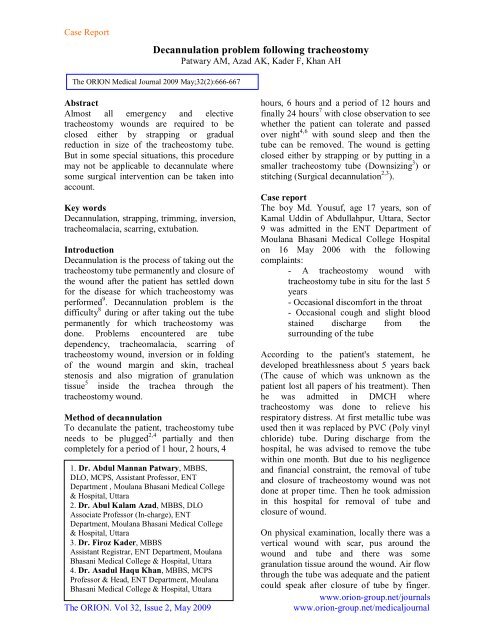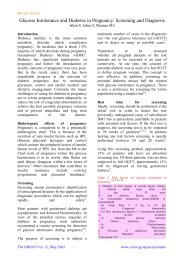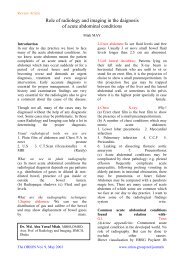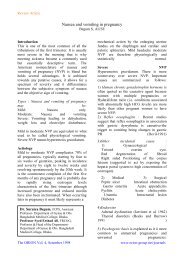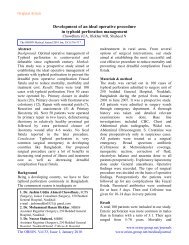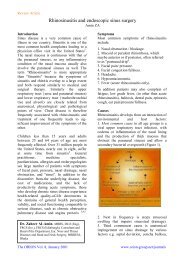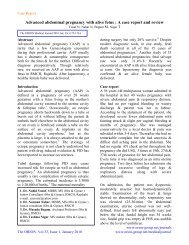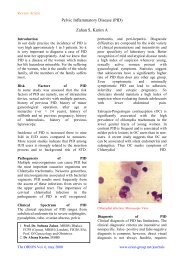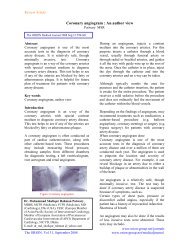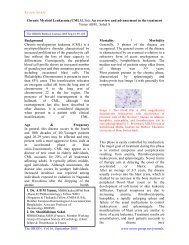Decannulation problem following tracheostomy - Orion Group
Decannulation problem following tracheostomy - Orion Group
Decannulation problem following tracheostomy - Orion Group
- No tags were found...
You also want an ePaper? Increase the reach of your titles
YUMPU automatically turns print PDFs into web optimized ePapers that Google loves.
Case Report<strong>Decannulation</strong> <strong>problem</strong> <strong>following</strong> <strong>tracheostomy</strong>Patwary AM, Azad AK, Kader F, Khan AHThe ORION Medical Journal 2009 May;32(2):666-667AbstractAlmost all emergency and elective<strong>tracheostomy</strong> wounds are required to beclosed either by strapping or gradualreduction in size of the <strong>tracheostomy</strong> tube.But in some special situations, this proceduremay not be applicable to decannulate wheresome surgical intervention can be taken intoaccount.Key words<strong>Decannulation</strong>, strapping, trimming, inversion,tracheomalacia, scarring, extubation.Introduction<strong>Decannulation</strong> is the process of taking out the<strong>tracheostomy</strong> tube permanently and closure ofthe wound after the patient has settled downfor the disease for which <strong>tracheostomy</strong> wasperformed 9 . <strong>Decannulation</strong> <strong>problem</strong> is thedifficulty 8 during or after taking out the tubepermanently for which <strong>tracheostomy</strong> wasdone. Problems encountered are tubedependency, tracheomalacia, scarring of<strong>tracheostomy</strong> wound, inversion or in foldingof the wound margin and skin, trachealstenosis and also migration of granulationtissue 5 inside the trachea through the<strong>tracheostomy</strong> wound.Method of decannulationTo decanulate the patient, <strong>tracheostomy</strong> tubeneeds to be plugged 2,4 partially and thencompletely for a period of 1 hour, 2 hours, 41. Dr. Abdul Mannan Patwary, MBBS,DLO, MCPS, Assistant Professor, ENTDepartment , Moulana Bhasani Medical College& Hospital, Uttara2. Dr. Abul Kalam Azad, MBBS, DLOAssociate Professor (In-charge), ENTDepartment, Moulana Bhasani Medical College& Hospital, Uttara3. Dr. Firoz Kader, MBBSAssistant Registrar, ENT Department, MoulanaBhasani Medical College & Hospital, Uttara4. Dr. Asadul Haqu Khan, MBBS, MCPSProfessor & Head, ENT Department, MoulanaBhasani Medical College & Hospital, UttaraThe ORION. Vol 32, Issue 2, May 2009hours, 6 hours and a period of 12 hours andfinally 24 hours 7 with close observation to seewhether the patient can tolerate and passedover night 4,6 with sound sleep and then thetube can be removed. The wound is gettingclosed either by strapping or by putting in asmaller <strong>tracheostomy</strong> tube (Downsizing 3 ) orstitching (Surgical decannulation 2,3 ).Case reportThe boy Md. Yousuf, age 17 years, son ofKamal Uddin of Abdullahpur, Uttara, Sector9 was admitted in the ENT Department ofMoulana Bhasani Medical College Hospitalon 16 May 2006 with the <strong>following</strong>complaints:- A <strong>tracheostomy</strong> wound with<strong>tracheostomy</strong> tube in situ for the last 5years- Occasional discomfort in the throat- Occasional cough and slight bloodstained discharge from thesurrounding of the tubeAccording to the patient's statement, hedeveloped breathlessness about 5 years back(The cause of which was unknown as thepatient lost all papers of his treatment). Thenhe was admitted in DMCH where<strong>tracheostomy</strong> was done to relieve hisrespiratory distress. At first metallic tube wasused then it was replaced by PVC (Poly vinylchloride) tube. During discharge from thehospital, he was advised to remove the tubewithin one month. But due to his negligenceand financial constraint, the removal of tubeand closure of <strong>tracheostomy</strong> wound was notdone at proper time. Then he took admissionin this hospital for removal of tube andclosure of wound.On physical examination, locally there was avertical wound with scar, pus around thewound and tube and there was somegranulation tissue around the wound. Air flowthrough the tube was adequate and the patientcould speak after closure of tube by finger.www.orion-group.net/journalswww.orion-group.net/medicaljournal
Case ReportAll investigations were normal. The patientwas treated conservatively by periodicantiseptic dressing to make the wound cleanand healthy under antibiotic coverage.When the wound became healthy, the tubewas removed and strapping was done. On thefirst day, the procedure was maintained forone hour under close observation, afterplugging of the tube lumen. On the successiveday the procedure was maintained for 3 hours,6 hours and upto 12 hours. When the patientcan maintain his normal breath after strappingof wound upto 24 hours without anyrespiratory <strong>problem</strong> and passed over nightwith sound sleep for few days and when thewound was not apposed together, then thewound was closed totally.The infolded skin was removed, and the skinmargin was made free well from underlyingstructure. Due to scarring the margin of thewound could not appose together, thenclosure of wound was done by 2/0 silk. Theprocedure was done under local anaesthesia.Case discussionTrachea (Wind Pipe) is a fibro cartilaginoushollow tube extends from lower part of theneck upto upper part of chest where it dividesand connects with the right and left lungrespectively by relatively narrow fibrocartilaginous hollow tube. It carries air duringrespiration. Above it connects with theLarynx. If for any reason (such as obstructionin the upper airway) one can not take breath,then it will be an emergency condition toestablish alternative pathway to maintainairway by making an opening in the anteriorwall of the trachea lies at the lower part of theneck called <strong>tracheostomy</strong>.Figure 1: Teacheostomywound with tube in situFigure 2: Stoma of <strong>tracheostomy</strong>wound with scar & unhealthygranulation tissue around itThe ORION. Vol 32, Issue 2, May 2009The patient with <strong>tracheostomy</strong> has to lead lifefor a while with utmost care of wound & tubeand after a certain period most of the casesthis alternate pathway required to be closedand reestablished the normal airway and thisprocess of closure of the wound is calleddecannulation. Most of the decannulation canbe done normally by simple strapping of thewound from side to side, prior to that it is tobe seen wheather the patient can passovernight with sound sleep either corking orsealing of the lumen of the <strong>tracheostomy</strong> tube.But in some cases this ordinary (Medicaldecannulation) process can not possible andneed some surgical measure. Where evenafter extubation the wound margins are notapposed together due to some reasons such asscarring of the wound, inversion of the woundmargin inside the lumen of the trachea,change of pattern of epithelial lining aroundthe lumen of the tracheal opening, evenformation of granulation tissue around thetracheal opening and consequently loss ofelasticity of the surrounding skin in longstanding case of <strong>tracheostomy</strong> wound otherthan repeated lower respiratory tract infection.Figure 3: Closure of teacheostomywound by stitchingFigure 4: Dressing of woundafter closureThis poor male patient aged 17 years hascome to the ENT department of MoulanaBhasani Medical College Hospital with ahistory of more than five years <strong>tracheostomy</strong>wound with tube in situ with unhealthy skinaround the <strong>tracheostomy</strong> tube with somegranulation tissue. His <strong>tracheostomy</strong> tube wastried to extubate after subsidence of infection<strong>following</strong> repeated cleaning and dressing forabout two weeks under antibiotic coverage.When the patient can pass over night withsound sleep after closing of the lumen of thetube then his wound was decided to closed.There was an elliptical stoma and the marginof the wound was partly inverted inside thelumen and change of pattern of thewww.orion-group.net/journalswww.orion-group.net/medicaljournal
Case Reportsurrounding skin of the stoma with poorelasticity and could not bring the margintogether from side to side by strapping forfew days.After that the surgical interference was donesuch as eversion of the margin of the skin &removal of granulation tissue, trimming of themargin of the skin and separation of the skinfrom the underlying subcutaneous tissue tosome extent then apposition of the skinmargin vertically together by 2/0 silk fromabove downwards with interrupted stitchesand dressed aseptically with pressure bandagewhich changed after 48 hours. The stitchesremoved after 7 days. And the patient wasdischarged with advice to attend ENT outpatient department after 2-3 weeks or if anydifficulty arises at any time for follow up.ConclusionDuring decannulation, one has to see whetherthe purpose of <strong>tracheostomy</strong> has served or notand also need to assess the way how to closethe wound for reestablishment of normalairway for respiration without any disturbanceof breathing.References1. Tracheostomy care handbook, change theoutcome.2. More on Decanulation, Decanulation,Michael Rothschild, MD, Director,Pediatric Otolaryngology Mount SinaiMedical Center file:/H:/ Decanulation.htm.3. Tracheostomy Ward decanulation,Information for families, Great OrmondStreet Hospital for Children NHS Trustwww.childrenfirst.nhs.UK.4. <strong>Decannulation</strong>, Principles from diseasesof Ear, Nose & Throat, Third Edition ByP.L. Dhingra, Published by Elsevier &division of Reed elsevier India PrivateLimited.5. Complications of tracheastomy fromBallenger's Otorhinolaryngology Head &Neck Surgery. 16th Edition, By James BSnow Jr. MD. John Jacob Ballenger MD.Published by ISBN-1 55009-1972, Printedin Spain page 1157-59.6. <strong>Decannulation</strong> from Steell & MaransHead & Neck Surgery 14th Edition, By-J.C. Watkinson, M.N.Gaze, J.A.Wilson,Published by Gray Publishing, TurnBridge Wells Kent. Printed & bound inIndia .7. After care of tracheastomy from lecturenotes on diseases of the Ear, Nose ofThroat, By P.D. Bull. 6th Edition.Published by Blackwell scientificpublications. Oxfort London Edinburgh,Boston Plo Alto Melborne.8. Difficulty with <strong>Decannulation</strong> from Scott-Brown's Otoleryngology -6th Edition,Volume - 5-5/7/16 Edited by John Hibbert.Butter Warth - Heinemann (B.H)International Editions. K.M.VargheseCompany Hind Rajasthan, Building.Dader, Mombai, 400 014.9. Decanulation- Fundamentals of Ear, Nose& Throat with Head-Neck Surgery ByDr.Shyamal Kumar De Published by theNew Book Stall (nbs) Calcultta. 7thEdition Page-475.The ORION. Vol 32, Issue 2, May 2009www.orion-group.net/journalswww.orion-group.net/medicaljournal


